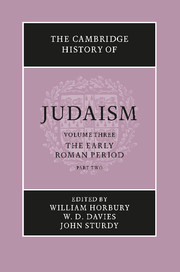Book contents
- Frontmatter
- 1 The archaeology of Palestine 63 bce–ce 70
- 2 The Herodian Temple
- 3 Recent archaeology in Palestine: achievements and future goals
- 4 The contribution of Jewish inscriptions to the study of Judaism
- 5 The social, economic and political history of Palestine 63 bce–ce 70
- 6 The Diaspora in the Roman period before ce 70
- 7 The Gentiles in Judaism 125 bce–ce 66
- 8 Gentiles as seen by Jews after ce 70
- 9 The synagogue
- 10 The Temple and the synagogue
- 11 The early liturgy of the synagogue
- 12 Women in the synagogue
- 13 The Pharisees
- 14 The Sadducees – their history and doctrines
- 15 The Essenes
- 16 The baptist sects
- 17 The troublemakers
- 18 The Samaritans and their sects
- 19 Galilean Judaism and Judaean Judaism
- 20 Jesus: from the Jewish point of view
- 21 Paul: from the Jewish point of view
- 22 Jewish Christianity
- 23 Apocalyptic: the disclosure of heavenly knowledge
- 24 The Qumran sectarian writings
- 25 The Dead Sea Scrolls and pre-Tannaitic Judaism
- 26 Prayer in the Qumran Texts
- 27 Philo of Alexandria
- 28 Josephus (ce 37–c. 100)
- 29 The rabbi in second-century Jewish society
- 30 The Hellenistic–Roman Diaspora ce 70–ce 235: the archaeological evidence
- 31 The legacy of Egypt in Judaism
- 32 Jewish elements in gnosticism and magic c.ce 70–c.ce 270
- Bibliographies
- Index
- References
10 - The Temple and the synagogue
Published online by Cambridge University Press: 28 March 2008
- Frontmatter
- 1 The archaeology of Palestine 63 bce–ce 70
- 2 The Herodian Temple
- 3 Recent archaeology in Palestine: achievements and future goals
- 4 The contribution of Jewish inscriptions to the study of Judaism
- 5 The social, economic and political history of Palestine 63 bce–ce 70
- 6 The Diaspora in the Roman period before ce 70
- 7 The Gentiles in Judaism 125 bce–ce 66
- 8 Gentiles as seen by Jews after ce 70
- 9 The synagogue
- 10 The Temple and the synagogue
- 11 The early liturgy of the synagogue
- 12 Women in the synagogue
- 13 The Pharisees
- 14 The Sadducees – their history and doctrines
- 15 The Essenes
- 16 The baptist sects
- 17 The troublemakers
- 18 The Samaritans and their sects
- 19 Galilean Judaism and Judaean Judaism
- 20 Jesus: from the Jewish point of view
- 21 Paul: from the Jewish point of view
- 22 Jewish Christianity
- 23 Apocalyptic: the disclosure of heavenly knowledge
- 24 The Qumran sectarian writings
- 25 The Dead Sea Scrolls and pre-Tannaitic Judaism
- 26 Prayer in the Qumran Texts
- 27 Philo of Alexandria
- 28 Josephus (ce 37–c. 100)
- 29 The rabbi in second-century Jewish society
- 30 The Hellenistic–Roman Diaspora ce 70–ce 235: the archaeological evidence
- 31 The legacy of Egypt in Judaism
- 32 Jewish elements in gnosticism and magic c.ce 70–c.ce 270
- Bibliographies
- Index
- References
Summary
During the period of the second temple (520 bce to ce 70) Judaism remained loyal to the past while sowing seeds for the future. It continued to maintain the temple, the priesthood, and the sacrificial cult, the legacies of the religion of pre-exilic Israel, but it also invented an institution of a completely different type, the synagogue. After the destruction of the second temple in ce 70, the synagogue gradually assumed a larger and larger role in Jewish society and consciousness. The synagogue is an enduring contribution of the second temple period to the history of Judaism, Christianity and Islam.
The origin of the synagogue is unknown, and, without a new discovery equal in magnitude to the Dead Sea scrolls, unknowable. The widely accepted theory that the synagogue originated in the sixth century bce during the Babylonian exile as a replacement for the Jerusalem temple seems plausible and attractive but is unsubstantiated and overly simplistic. Unsubstantiated, because it is not supported by a single ancient source. Overly simplistic, because it assigns to a single time and place the origin of a most complex institution. The earliest extant reference to a synagogue is an inscription from Upper Egypt from the third century bce which uses the term proseuche, ‘prayer(-house)’. The earliest known Judaean synagogue is the building erected in Jerusalem by one Theodotus in the first century bce or ce ‘for the reading of the law and the teaching of the commandments’, not, apparently, for the recitation of prayer. Ancient synagogues also served as assembly halls or community centres, much as the temple itself often did.
- Type
- Chapter
- Information
- The Cambridge History of Judaism , pp. 298 - 325Publisher: Cambridge University PressPrint publication year: 1999
References
- 2
- Cited by



